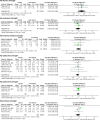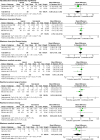Biomechanical and Musculoskeletal Measurements as Risk Factors for Running-Related Injury in Non-elite Runners: A Systematic Review and Meta-analysis of Prospective Studies
- PMID: 35254562
- PMCID: PMC8901814
- DOI: 10.1186/s40798-022-00416-z
Biomechanical and Musculoskeletal Measurements as Risk Factors for Running-Related Injury in Non-elite Runners: A Systematic Review and Meta-analysis of Prospective Studies
Abstract
Background: Running-related injury (RRI) is highly prevalent among recreational runners and is a key barrier to participation. Atypical lower limb alignment and mechanical function have been proposed to play a role in development of lower extremity injury. The purpose of this study was to investigate relationships between incidence of running-related injury (RRI) in non-elite runners with biomechanical and musculoskeletal variables.
Methods: A systematic review and meta-analysis of prospective studies. Published research indexed in MEDLINE, EMBASE, CINAHL, SPORTDiscus, AMED, and The Cochrane library until 13th January 2021, grey literature, and reference lists of included studies were screened to identify prospective studies of non-elite adult runners that measured a relationship between biomechanical or musculoskeletal measures and incidence of RRI.
Results: Thirty studies (3404 runners), testing over 100 discrete biomechanical and musculoskeletal risk factors for RRI, were included. Nineteen studies were pooled in twenty-five separate meta-analyses. Meta-analysis of four studies detected significantly less knee extension strength among runners who developed a RRI (SMD - 0.19, 95% CI - 0.36 to - 0.02, p = 0.03), though this may not be clinically important. A meta-analysis of two studies detected significantly lower hip adduction velocity among runners who developed a RRI (MD - 12.80, 95% CI - 25.22 to - 0.38, p = 0.04). Remaining meta-analyses found no significant relationship between biomechanical or musculoskeletal variables and RRI.
Conclusion: This systematic review and meta-analysis found the currently available literature does not generally support biomechanical or musculoskeletal measures as risk factors for RRI in non-elite runners. While meta-analysis findings for knee extension strength and hip adduction velocity as risk factors for RRI were statistically significant, the associated trivial to small effects sizes suggest these findings should be treated with caution. Until further evidence emerges, recommendations for injury prevention in non-elite runners cannot be made based on biomechanical and musculoskeletal measurements alone.
Keywords: Biomechanics; Meta-analysis; Risk factor; Running-related injury; Screening; Systematic review.
© 2022. The Author(s).
Conflict of interest statement
Five of the authors (Benjamin Peterson, Martin Spink, Fiona Hawke, Robin Callister, Vivienne Chuter) of this review are authors of the ongoing study ‘Peterson (2020)’ [53] and provided additional data for re-analysis in this review. Sean Sadler and Morgan Hawes declare that they have no potential competing interests relevant to the content of this review.
Figures







Similar articles
-
Relationships between Running Biomechanics, Hip Muscle Strength, and Running-Related Injury in Female Collegiate Cross-country Runners.Int J Sports Phys Ther. 2022 Oct 1;17(6):1053-1062. doi: 10.26603/001c.38017. eCollection 2022. Int J Sports Phys Ther. 2022. PMID: 36237650 Free PMC article.
-
Lower limb alignment characteristics are not associated with running injuries in runners: Prospective cohort study.Eur J Sport Sci. 2016 Nov;16(8):1137-44. doi: 10.1080/17461391.2016.1195878. Epub 2016 Jun 17. Eur J Sport Sci. 2016. PMID: 27312709
-
Biomechanical risk factors for running-related injury differ by sample population: A systematic review and meta-analysis.Clin Biomech (Bristol). 2020 May;75:104991. doi: 10.1016/j.clinbiomech.2020.104991. Epub 2020 Mar 14. Clin Biomech (Bristol). 2020. PMID: 32203864
-
Previous injuries and some training characteristics predict running-related injuries in recreational runners: a prospective cohort study.J Physiother. 2013 Dec;59(4):263-9. doi: 10.1016/S1836-9553(13)70203-0. J Physiother. 2013. PMID: 24287220
-
Biomechanical Risk Factors Associated with Running-Related Injuries: A Systematic Review.Sports Med. 2019 Jul;49(7):1095-1115. doi: 10.1007/s40279-019-01110-z. Sports Med. 2019. PMID: 31028658
Cited by
-
Resistance Exercise for Improving Running Economy and Running Biomechanics and Decreasing Running-Related Injury Risk: A Narrative Review.Sports (Basel). 2022 Jun 24;10(7):98. doi: 10.3390/sports10070098. Sports (Basel). 2022. PMID: 35878109 Free PMC article. Review.
-
Low Back Pain or Injury Before Collegiate Athletics, a Potential Risk Factor for Noncontact Athletic Injuries.J Athl Train. 2025 Feb 1;60(2):170-176. doi: 10.4085/1062-6050-0151.24. J Athl Train. 2025. PMID: 39287079
-
Field-Based Gait Retraining to Reduce Impact Loading Using Tibial Accelerometers in High-Impact Recreational Runners: A Feasibility Study.Sensors (Basel). 2025 Mar 10;25(6):1712. doi: 10.3390/s25061712. Sensors (Basel). 2025. PMID: 40292796 Free PMC article.
-
Predicting overstriding with wearable IMUs during treadmill and overground running.Sci Rep. 2024 Mar 15;14(1):6347. doi: 10.1038/s41598-024-56888-4. Sci Rep. 2024. PMID: 38491093 Free PMC article.
-
Predicting Vertical Ground Reaction Forces in Running from the Sound of Footsteps.Sensors (Basel). 2022 Dec 8;22(24):9640. doi: 10.3390/s22249640. Sensors (Basel). 2022. PMID: 36560009 Free PMC article.
References
-
- Parma Yamato T, Tirotti Saragiotto B, Dias LA. A consensus definition of running-related injury in recreational runners: a modified Delphi approach. J Orthop Sports Phys Ther. 2015;45(5):375–380. - PubMed
-
- Dempster J, Dutheil F, Ugbolue UC. The prevalence of lower extremity injuries in running and associated risk factors: a systematic review. Phys Activ Health. 2021;5(1):133–145.
Publication types
LinkOut - more resources
Full Text Sources

